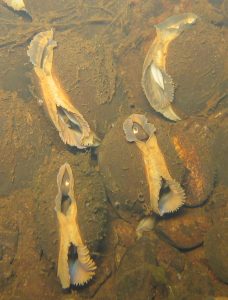
Photo credit: Eugene Ross
There are many animals in Ireland that are under threat from various sources, and the freshwater pearl mussel (Margaritifera margaritifera) is catching it from all sides.
Freshwater pearl mussels, like the saltwater mussels we eat, are bivalves. Bivalves are molluscs with soft bodies protected by a hinged shell which can open and close as they need. They have one strong ‘foot’ which they use to burrow into gravel and sand, and a long tubelike siphon which they use to filter feed. Freshwater pearl mussels display reduced senescence, or reduced aging. They can live to be 140, making them the longest-lived animals in Ireland.
Freshwater pearl mussels live in fast-flowing freshwater. They’re very particular about their habitats, as the juveniles cannot survive in poor quality water. Damage to our waterways has caused a decline in mussel populations, and even the groups living in clean rivers are struggling to reproduce as the juveniles just aren’t surviving. Pearl mussels have a very complex life cycle which slows the rate at which their populations can recover once they decline.
Males will eject their sperm into the water, and then the females inhale that sperm to fertilise their eggs. After that, the females release millions of tiny juveniles called glochidia into the water, where they attempt to latch onto the gills of a passing salmon or trout. The vast majority of glochidia don’t make it, which is why the females produce such immense numbers of offspring.
If the glochidia are lucky, they’ll find a suitable host fish and ride around on its gills for about nine months. After that, they drop off, and if they get lucky again, they’ll drop off into the gravel on the bed of a clean, fast-flowing river. Once they’re on the river bed, juvenile mussels burrow into the gravel to escape the current, where they spend five years waiting and growing.
If the juveniles can survive the full five years in the riverbed, they’ll finally be big enough and strong enough to withstand the river current. At that point, they emerge from the gravel and begin filter-feeding. They still aren’t adults yet, though. Freshwater pearl mussels don’t reach maturity until they’re about twelve years old. That’s a lot of time for something to go wrong.
Because they begin life as parasites attached to salmonid fish, pearl mussels need those fish to have healthy populations to have any chance at reproducing. Sadly, salmon and trout are threatened in their own ways, making it even harder for the mussels to get a foothold.
Even if they find the right kind of fish to latch onto and successfully drop off onto the river bed, juvenile pearl mussels are highly sensitive to pollution and disruption of water flow, even more so than the adults. If there’s too much silt or algae, it can prevent them from taking in enough oxygen while buried in the river bed. Agricultural pollution can cause algae blooms and physical modifications to rivers can stir up sediment that suffocates the juveniles before they ever have a chance.
The high mortality rate of juvenile pearl mussels is a huge part of why their populations are declining, even in the ‘top 8 catchments’ which have the largest populations. Since very few mussels are surviving to reach breeding age, the population is growing older over time and can’t replenish itself.
All of these factors combine to make pearl mussels a critically endangered species in Ireland and one of the top 365 most endangered species worldwide. Protecting and preserving them requires a lot of measures to restore and maintain freshwater habitats. Changing agricultural practices to be kinder on water bodies is key going forward.
Although they’re worth protecting for their own sake, freshwater pearl mussels are also very important animals for maintaining water quality. As they filter feed, they inhale up to 50 litres of water a day each and remove and consume organic food particles before spitting out cleaned water. In places where there are a lot of pearl mussels grouped together, their combined filtration activity works to clean the water out and improve its overall quality.
If you’re interested in learning more about the kind of measures that can be taken to restore the crucial habitats freshwater pearl mussels live in, you can watch our webinar series on the Water Framework Directive over on our website’s webinars page.
By Grace Bettayeb